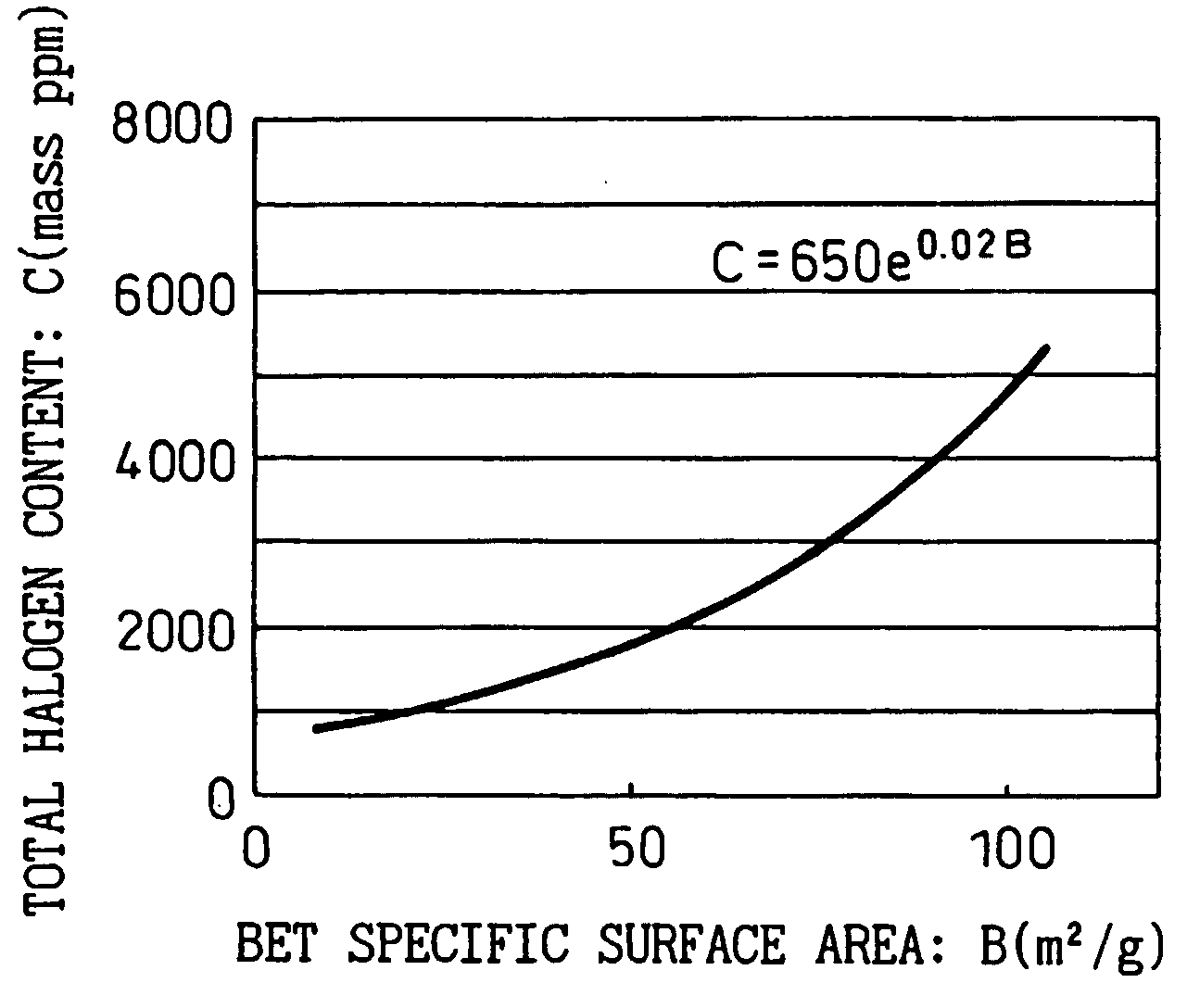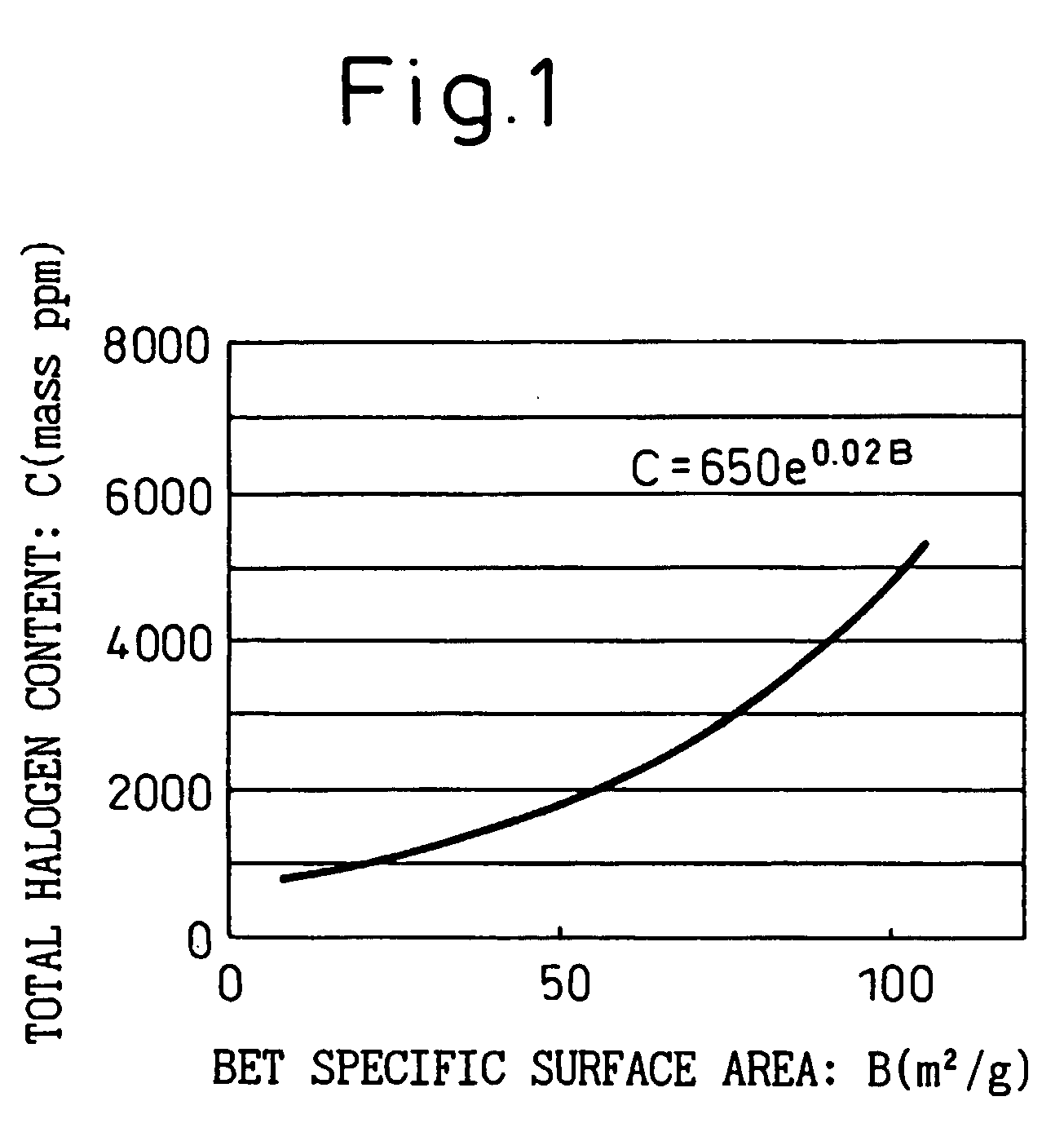Ultrafine particulate titanium oxide with low chlorine and low rutile content, and production process thereof
a technology of titanium oxide and rutile content, which is applied in the field of ultraviolet-type particulate titanium oxide with low chlorine and low rutile content, can solve the problems of limited use of photocatalysts, increased light scattering of titanium oxide, and low dispersibility of titanium oxide,
- Summary
- Abstract
- Description
- Claims
- Application Information
AI Technical Summary
Benefits of technology
Problems solved by technology
Method used
Image
Examples
example 1
A diluted titanium tetrachloride gas which had been prepared by diluting gaseous titanium tetrachloride (11.8 Nm3 / hr, wherein N refers to “normal state,” the same shall apply hereinafter) with nitrogen gas (8 Nm3 / hr) was preliminarily heated to 900° C. Separately, an oxidative gas which had been prepared by mixing oxygen (8 Nm3 / hr) with steam (32 Nm3 / hr) was preliminarily heated to 800° C. These raw material gases were introduced into a quartz-glass-made reaction tube. Cooling air was introduced into the reaction tube such that the residence time of the raw material gasses at a temperature of at least 800° C. but less than 1,100° C. was 0.1 seconds, and subsequently the resultant ultrafine particulate titanium oxide powder was collected by use of a polytetrafluoroethylene-made bag filter.
The thus-obtained titanium oxide powder was cause to flow through a cylindrical rotatable heating furnace, and subjected to dechlorination under the following conditions: mass ratio of water to t...
example 2
A diluted titanium tetrachloride gas which had been prepared by diluting gaseous titanium tetrachloride (5.9 Nm3 / hr) with nitrogen gas (30 Nm3 / hr) was preliminarily heated to 1,000° C. Separately, an oxidative gas which had been prepared by mixing oxygen (4 Nm3 / hr) with steam (16 Nm3 / hr) was preliminarily heated to 1,000° C. These raw material gases were introduced into a quartz-glass-made reaction tube. Cooling air was introduced into the reaction tube such that the residence time of the raw material gasses at a temperature of at least 800° C. but less than 1,100° C. was 0.03 seconds, and subsequently the resultant ultrafine particulate titanium oxide powder was collected by use of a polytetrafluoroethylene-made bag filter.
The thus-obtained titanium oxide powder was fed to a hot-air circulation heating furnace, and subjected to dechlorination under the following conditions: mass ratio of water to titanium oxide: 0.04, heating temperature: 450° C. The thus-dechlorinated titanium ...
example 3
A diluted titanium tetrachloride gas which had been prepared by diluting gaseous titanium tetrachloride (4.7 Nm3 / hr) with nitrogen gas (36 Nm3 / hr) was preliminarily heated to 1,000° C. Separately, an oxidative gas which had been prepared by mixing air (36 Nm3 / hr) with steam (25 Nm3 / hr) was preliminarily heated to 1,000° C. These raw material gases were introduced into a quartz-glass-made reaction tube. Cooling air was introduced into the reaction tube such that the residence time of the raw material gasses at a temperature of at least 800° C. but less than 1,100° C. was 0.02 seconds, and subsequently the resultant ultrafine particulate titanium oxide powder was collected by use of a polytetrafluoroethylene-made bag filter.
The thus-obtained titanium oxide powder was fed to a hot-air circulation heating furnace, and subjected to dechlorination under the following conditions: mass ratio of water to titanium oxide: 0.06, heating temperature: 350° C. The thus-dechlorinated titanium ox...
PUM
| Property | Measurement | Unit |
|---|---|---|
| Temperature | aaaaa | aaaaa |
| Temperature | aaaaa | aaaaa |
| Temperature | aaaaa | aaaaa |
Abstract
Description
Claims
Application Information
 Login to View More
Login to View More - R&D
- Intellectual Property
- Life Sciences
- Materials
- Tech Scout
- Unparalleled Data Quality
- Higher Quality Content
- 60% Fewer Hallucinations
Browse by: Latest US Patents, China's latest patents, Technical Efficacy Thesaurus, Application Domain, Technology Topic, Popular Technical Reports.
© 2025 PatSnap. All rights reserved.Legal|Privacy policy|Modern Slavery Act Transparency Statement|Sitemap|About US| Contact US: help@patsnap.com


